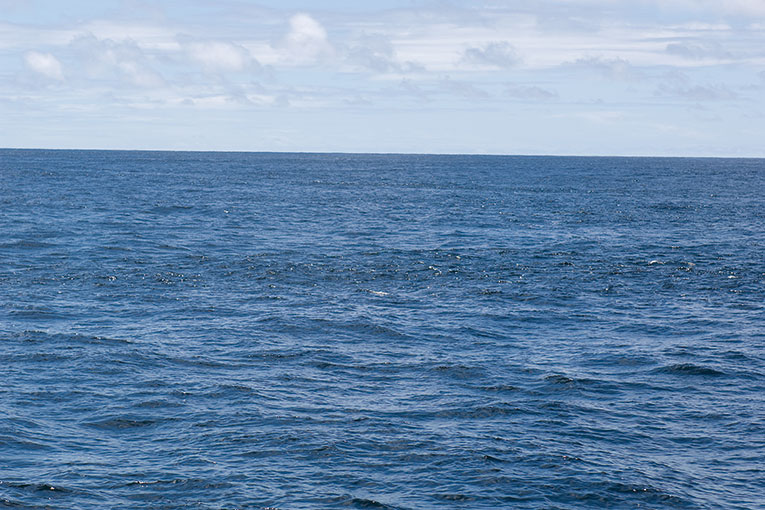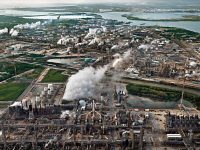The climate’s oceanic memory
The circulatory system of a living planet

ABSTRACT
In the early sixteenth century, Leonardo da Vinci compared the ocean currents with the blood flow of a human body. Now we have enough information to explore the idea that the Earth has a circulatory system responsible for capturing, transforming and distributing solar energy. The role of the ocean as a climate regulator is extraordinary, and it truly determines the present and the future of our planet.
Keywords: ocean circulation, climate change, oceanography.
Five hundred years ago, in the early sixteenth century, Leonardo da Vinci had enough intuition, and perhaps even the imagination, to compare the oceanic currents to the fl ow of blood. He had studied the anatomy of the human body and knew that the role of the arteries and veins is to carry oxygenated blood and nutrients to all parts of the body, thus becoming the source of energy for life. But Leonardo had no way of knowing that the ocean currents actually play this energytransfer role in our planet. This is where we see his genius’ intuition!
«The ocean is the largest area harbouring metabolically active life, at levels well above the lithosphere, atmosphere and terrestrial biosphere»
The human body captures nutrients and oxygen from the environment and distributes them to all the body’s cells with the aid of the circulatory system. The body’s design is optimized through evolution to take advantage of these external resources in the best way possible. Energy also reaches the Earth, a virtually inexhaustible source of solar radiation, and the Earth as a living system has evolved to take advantage of it. We may ask ourselves: where is life on Earth? The answer is clear: the largest mass with metabolically active life is the ocean, at a level well above the lithosphere, the atmosphere and the terrestrial biosphere. Solar energy, either as heat or converted into various forms –like organic matter, a product of photosynthesis– has to reach all parts of the marine system. Similarly, it is necessary for nutrients to reach the places where photosynthetic transformation occurs. Ocean currents are responsible for all those processes, a vital link in keeping the fl ow of energy and life on our planet (Pelegrí, 2008).

Just like living beings with two distinct circuits, the major ocean currents also have two well-defi ned routes: the deep meridional overturning circulation and the thermocline circulation. The main picture illustrates the predominant paths of the meridional overturning circulation, which begins in the northern and southern Atlantic Ocean and connects the deep (blue and green lines), intermediate (orange and red lines) and surface waters (purple lines) of all oceans. The inserted picture shows the surface colour of the North Atlantic Ocean during the spring of 2003, as seen by the SeaWiFS satellite sensor, with a diagram showing path of the thermocline circulation. Starting at the surface in high latitudes, it revolves through the basin at depths of several hundred meters to fi nally return to its place of origin. Similar circuits take place in all major oceans of the Earth. / Talley, 2013
Today, unlike the times when Leonardo lived, we have enough data to quantitatively explore whether indeed we can draw an analogy between the flow of water in the oceans –representing the Earth’s circulatory system–,and the blood, arteries and veins of a living creature. And the result is that, in fact, there are very striking similarities. In the same way in which the blood fl ow in mammals begins at the heart, during contraction phase (systole), all major ocean currents, except the most superficial, also have their origin in the planet’s colder regions during the winter. The basic frequency of this planetary circulatory system, that is, the time it takes to beat, is one year. Large currents begin the route deep inside the ocean for a few weeks in winter either due to an intense cooling of the surface waters, or at depths of several hundred meters, by the combined action of surface cooling and wind.
«Just as blood flow in mammals begins in the heart, so the great ocean currents originate in the coldest regions in winter, in colder regions of the planet»
In the ocean, the equivalent to the systemic circuit is the overturning meridional circulation, popularized (Broecker, 1991) as the global conveyor belt. Its name indicates that it is a belt with two pulleys, but where only one is active, continuously transporting materials always to return to the same starting point. This is a relatively long and slow circuit, which will take about 1,000 years to make a full turn. The circuit begins in the high-latitude subpolar oceans and fl ows, distant from the atmosphere, through all the Earth’s deep oceans. It eventually returns the near-bottom waters, rich in inorganic nutrients, to the sea surface regions, to a large degree through the equatorial Atlantic Ocean. Similarly, the equivalent to the pulmonary circulation is the thermocline circuit, where the waters fl ow across the top thousand meters of the surface subtropical regions in a relatively short time, about just ten years. This circuit starts near the sea surface, in contact with the atmosphere, where the waters are charged with organic matter and oxygen. As these waters sink away from the sea surface the oxygen is used for breathing, and the organic matter is transformed into inorganic matter. Thus, the water will return to the surface charged with the inorganic nutrients required for the conversion of solar energy into organic matter through photosynthesis. (Pelegrí et al., 2006).

The MOC2-Equatorial expedition was carried out aboard the Oceanographic Research Vessel Hespérides from Fortaleza (Brazil) to Mindelo (Cape Verde). In total, there were 42 days of navigation during April and May 2010 in the tropical and equatorial Atlantic Ocean involving researchers from various national and international institutions. / Marc Gasser
The left ventricle of the terrestrial heart is located in the sub-polar regions of the planet, both in the northern hemisphere (Labrador Sea and Greenland Sea) and around the Antarctic continent. It is there that each winter the dense waters are formed, a clear beat representing the starting point of the meridional overturning circulation, the great deep arteries. These waters begin a long journey that will keep them away from the atmosphere during one millennium before returning, as in all conveyor belts, to their starting point. In the fi nal stages of their trip, before reaching the polar regions of the northern hemisphere, these waters become shallow in the equatorial Atlantic Ocean, which hence becomes the right atrium of the Earth’s heart. Here the ocean’s veins arrive with virtually imperceptible seasonal heart beats. After a trip of nearly a millennium, the waters arrive back to the illuminated ocean regions, retaining a trace of the properties they had when they escaped from the surface, as if keeping a small memory of past climates on Earth.
The waters that are on their way to the equatorial Atlantic, to return to the ocean surface, are called the intermediate Antarctic waters. They are relatively fresh and very cold waters, becausethey come from around the Antarctic continent, which stores millions of cubic kilometres of ice. Upon reaching the surface, these waters have the ability to incorporate large amounts of solar radiation, which will then be distributed to higher latitudes (Rahmstorf, 2002). In the equatorial and tropical ocean, currents travel predominantly in a zonal direction, between the American and African continents. All these streams, however, are connected to the western margin, where an intense meridional fl ow along the northern shore of South America, the North Brazil Current, connects the waters of both hemispheres.
The North Brazil Current represents the fi rst of the fi nal stages in the long journey of the deep meridional overturning circulation, which began one distant winter a thousand years ago; these fi nal stages are made up of fast surface currents, so in about only one year, they pass through the Caribbean (the Guyana and the Caribbean currents) and continue along the eastern coast of America to the subpolar regions (Gulf Stream and North Atlantic current). The waters of the North Brazil Current transport large amounts of heat to the northernmost regions of the Atlantic and allow, among other things, for northern Europe to have a mild climate. Part of this heat fl ow comes from the Indian Ocean, an ocean closed to the north, which causes the whole radiative heat stored in this tropical region to go south. This heat may partially escape into the Atlantic through the Agulhas Current, but a large part is just the result of the warming of Antarctic waters during their transit through the South and Equatorial Atlantic.
«After nearly a millennium, the waters arrive back to the illuminated ocean, retaining a trace of the properties they had when they escaped from sea surface»
Researchers at the Institute of Marine Sciences (ICM) of the CSIC (Spanish National Research Council) have studied these processes thanks to the project Oceanic Memory of Climate (Memoria oceánica del clima). Their objective was to study the fi nal stage in the Earth’s systemic circuit: the equatorial regions where the end of the deep meridional overturning circulation ends up its subsurface trip. This project has increased our understanding of the oceans’ role in controlling Earth’s climate, by studying one of the most relevant regions: the equatorial Atlantic Ocean.

The rosette-CTD-LADCP is a sampling unit comprising several sensors (to measure salinity, temperature, pressure, fluorescence, dissolved oxygen and fl ow speed) and twenty-four 12-litre bottles (to take water samples at different depths that may be used for the analysis of many other parameters). The results allow examining how these properties change with depth and what characterizes the different water bodies. / Alicia Duró
One of the main activities undertaken by the project was the MOC2-Equatorial oceanographic cruise. The main objective of this expedition was to investigate the extent of the transport and transformations experienced by intermediate waters on their journey from the Southern Ocean to the Equatorial Atlantic. One question was: What is the energy source that allows these waters to fl ow north? Every winter the deep waters are formed at high latitudes of the North Atlantic, but we do not know where they get the energy necessary to return to these same regions. The beginning of the path seems clear: the deep waters are formed by a density increase during the winter cooling, which creates a pressure gradient that drives them south. However, is that energy enough for the water parcels to travel thousands of miles around the planet, slowly climbing the water column until returning to the Atlantic Ocean surface? Calculations indicate that it is not enough, and that for the water to continue its long journey it will require additional energy sources. The first are the strong winds blowing over the subtropical gyres, the large central oceanic regions. The second source of energy is thought to originate in the equatorial region, with a wonderful combination of the seasonal variation in solar radiation and the tropical wind system. The latter acts like a peristaltic pump, carrying the waters to the surface and ejecting them northward until they are incorporated into the zonal tropical current system, to eventually reach the North Brazil Current (Castellanos, 2012).
As part of the expedition a transatlantic section was carried out along latitude 7.5°N. This is the fourth time in the history of oceanography that this section has been studied. The ocean absorbs about half of the globe’s anthropogenic carbon, thus weakening the greenhouse effect. Because of its ability to store large amounts of heat with very small changes in temperature, the ocean is the great regulator of the planet’s temperature. The importance of the section along 7.5°N is that we can quantify how much heat, along with other relevant properties such as carbon, are incorporated by the oceanic compartment in the South and Equatorial Atlantic Oceans and what are the meridional fluxes of these particular properties into the North Atlantic Ocean.

Some stations have launched instrumented drifting buoys that will transmit data on the ocean for years to come. / Larraitz Lizarazu
As for the expedition’s results, we have been able to determine the structure and spatial connections of numerous properties throughout this great equatorial region. Among the more specifi c results, we have determined the high intensity and depth of the North Brazil Current and found that part of this current is diverted to the east, at the equator all year long and close to 7°N (from April to September), and the other part continues into the Caribbean. We have been greatly surprised by the extraordinary complexity of the different water masses that appear in this region, at very different depths, turning this area into a neural hub which connects waters of austral, subtropical and tropical origins.
In conclusion, we can say that the oceans are responsible for the present and future climate of the Earth, as they are true regulators of the Earth system. Not only is the ocean’s mass much greater than the mass of the atmosphere, cryosphere, biosphere and pedosphere (the outermost portion, or skin, of the lithosphere), but it also stores a much greater amount of those properties which are essential for Earth’s functioning, such as heat, carbon and inorganic nutrients. When we look at the ocean on the distant horizon we do not realize that, under its surface there is another landscape. But as we look inward, we can see changes in its characteristics that speak of different origins and very different physical and biogeochemical transformations. Beneath the surface we see how different waters are mixed along their route and how changes between organic and inorganic matter take place.
«The changes the Earth experiences as it passes from glacial to interglacial stages are similar to those experienced by the metabolism of a living being when it changes from a state of rest to one of greater activity»
Studies such as the ones described here give us basic tools in the understanding of the role played by the great oceanic currents in the distribution of different properties within the ocean, showing us how these currents are organized spatially and temporally, and helping to anticipate what may be the future evolution of our planet’s climate.
Leonardo and curiosity for water
Leonardo was born in 1452 in a village named Vinci in the Montalbano region, surrounded by vineyards and olive trees, halfway between Florence and Pisa. It may seem a small corner of the world, but in reality it lay on one of the main roads in Italy. From a young age he was highly interested in understanding nature, both aesthetically and conceptually (Pescio, 2001).
Leonardo was among the first to implement the scientific method, searching for laws through experimentation (Pigem, 2009). Harald Höffding presents Leonardo’s contemplation as a mixture of empiricism and naturalism. For Leonardo «Wisdom is the daughter of experience», the only one that can verify insights and theories: «Experience never errs; it is only your judgements that err by promising themselves effects such as are not caused by your experiments». His vision of unity was possibly a source of inspiration for new systemic and holistic approaches, so in vogue. Even today we feel wonder at his definition of science as the observation of all things possible («notitia delle cose che sono possibili»). He undertook rigorous observation and experimentation, as well as the exact formulation of general principles from experience.
«Like Leonardo, it is only by opening our eyes to the planet Earth as a whole, will we know it better and live together in greater harmony»
By the year 1515 he had created the series of drawings Deluge part of the Windsor collection, and the Codex Atlanticus, which represented atmospheric phenomena, such as lightning and thunder storms and water fl ows with swirls. In his Treatise on water he considered the constitution of the universe, and argued in favour of a general analogy between humans and the world. Leonardo wished to capture the essence of the basic elements of nature (earth, water, air, fi re) and understand their function (Brion, 1998). He was to wonder what makes up the elements and how their structure determines function. In this case, Leonardo the scientist examined cause and effect relationships and formulated laws. How is nature organized? What relationships exist? What are the relationships between the elements of nature that give life to Earth?
Leonardo was not only a great thinker but also an extraordinary inventor. It seemed easy for him to conceive the elemental world from the observation of phenomena. He studied the different movements of water, such as swirls, waves and rain with a vision of the whole while retaining a precise observation of detail. And as any good scientist, when he had captured everything he wanted through observation, he had to discuss it with other people. So he liked to talk about his favourite element, water, to learn more about it. And as one can easily see in many of his illustrations, Leonardo’s observations and studies take on picture form. For instance, his observations on fl owing water or turbulence are refl ected in many of his drawings.
Leonardo respected water, which he considered «the blood of the Earth». His intuition of a cosmic unity, along with a penchant for analogies, led him to explore the similarity between the human body and the Earth: in the former, the journey through the blood’s circulatory system; while in the latter, the ocean currents. We fi nd examples in his notebooks and fragments of theTreatise on water, which adeptly express the idea: «As from the pool of blood proceed the veins which spread their branches through the human body so the ocean fi lls the body of the Earth with an infi nite number of veins of water…» Today, thanks to
Today, thanks to physical oceanography, we can study the movements of ocean waters and their properties, and create models to forecast the evolution of the oceans and their effects on Earth’s climate. Technology and oceanographic instrumentation are our brushes to paint seascapes and study their behaviour. But, like Leonardo, it is only by opening our eyes to the planet Earth as a whole, will we know it better and live together in greater harmony.
Bibliography
Brion, M.,1998. «Leonardo da Vinci: Alabanza del agua». Elementos, 32: 7.
Pescio, Cl., 2001. Leonardo. Art and Science. Giunti Editore S.P.A. Florence-Milan.
Pigem, J., 2009. «La ciència de Leonardo da Vinci». Mètode, 61: 16-19.
Details of the oceanographic expedition
The MOC2-Equatorial expedition was conducted aboard the research vessel Hespérides between April 5 and May 17, 2010, with 55 crew and 34 researchers and technicians. This expedition was part of the project Memòria oceànica del clima, run by the research staff of the Institute of Marine Sciences between 2009 and 2011. The cruise started at the city of Fortaleza (Brazil) and ended in Mindelo (Cape Verde). For 42 days many interdisciplinary oceanographic measurements were taken, in two phases, in the Equatorial Atlantic. The first phase covered a region north from Brazil, 1.5ºN and 32º W; and the second one was a transatlantic section along 7.5º N, leaving Brazil and arriving in Sierra Leone. A total of 110 hydrographic stations carried out, with physical, chemical, and biological measurements; physical variables were measured with high vertical resolution and , water samples were taken at 24 depths from the surface to the sea bed, in some cases at depths over 4,000 meters, for multiple chemical, biological and biogeochemical analyses. In addition, a total of 14 instrumented drifting buoys were launched at several stations.
Variables measured were of three types: continuous data, which are those taken without the boat stopping; the data obtained with the instrumented drifters dragged at 60 m; and measurements at the hydrographic stations. Continuous data include surface temperature and salinity, meteorological data and current speed up to about 500 meters in depth. The buoys transmit, via satellite, their position, from which the speed of the subsurface current can be deduced, as well as the temperature and salinity at the surface and at about 60 m deep. The measurements at stations are the most complete and include physical, chemical and biogeochemical variables. Among others, the following have been measured: physical properties of water (salinity, temperature, speed, fluorescence, turbidity, microscale vertical shear), dissolved oxygen and inorganic nutrients (nitrites, nitrates, silicates and phosphates), organic matter (particulate carbon and phosphorus, organic carbon and total phosphorus, dissolved organic matter, fluorescent and coloured), several other chemical properties (pH, alkalinity, methane, carbonates, dissolved inorganic carbon, chlorofluorocarbons, helium) and various biological properties (respiration, primary production, chlorophyll a, cellular structure, phytoplankton, bacteria and tiny algae called Parmales).
Bibliography
Benítez-Barrios, V. M., 2011. «Multiscale Variability in the North Atlantic Ocean». Doctoral thesis, Universidad de Las Palmas de Gran Canaria.
Broecker, W. S., 1991. «The Great Ocean Conveyor». Oceanography, 4(2): 18-89. DOI: <10.5670/oceanog.1991.07>.
Castellanos, P., 2012. «Wind-driven Currents in the Coastal and Equatorial Upwelling Regions». Doctoral thesis, Universitat Politècnica de Catalunya.
Claret, M.; Rodríguez, R., & J. L. Pelegrí, 2012. «Salinity Intrusion and Convective Mixing in the Atlantic Equatorial Undercurrent». Scientia Marina,76(S1): 117-129. DOI: <10.3989/scimar.03611.19B>.
Paillard, D., 2001. «Glacial Cycles: Towards a New Paradigm». Reviews of Geophysics, 39: 325-346. DOI: <10.1029/2000RG000091>.
Pelegrí, J. L., 2008. «A Physiological Approach to Oceanic Processes and Glacial-interglacial Changes in Atmospheric CO2». Scientia Marina, 72: 185-202. DOI: <10.3989/scimar.2008.72n1185>.
Pelegrí, J. L., Marrero-Díaz, A., & A. W. Ratsimandresy, 2006. «Nutrient Irrigation of the North Atlantic». Progress in Oceanography, 70: 366-406. DOI: <10.1016/j.pocean.2006.03.018>.
Pelegrí, J. L.; De la Fuente, P.; Olivella, R., & A. García-Olivares [en prensa]. «Global Constraints on Net Primary Production and Inorganic Carbon Supply During Glacial and Interglacial Cycles». Paleoceanography.
Rahmstorf, S., 2002. «Ocean Circulation and Climate During the Past 120,000 Years». Nature 419: 207-214. DOI: <10.1038/nature01090>.
San Antolín Plaza, M. A.; Pelegrí, J. L.; Machín, F. J., & V. M. Benítez, 2012. «Inter-decadal Changes in Stratification and Double Diffusion in a Transatlantic Section Along 7.5º N». Scientia Marina, 76(S1): 189-207. DOI: <10.3989/scimar.03616.19G>.
Talley, L. D., 2013. «Closure of the Global Overturning Circulation Through the Indian, Pacific, and Southern Oceans: Schematics and Transports.» Oceanography, 26(1): 80-97. DOI: <10.5670/oceanog.2013.07>
Agraïments: La campanya oceanogràfica MOC2-Equatorial es va fer com a part del projecte Memoria Oceánica del Clima: mecanismos y rutas de formación de aguas superficiales en el Atlántico ecuatorial (MOC2), referència CTM2008-06438-C02-01, finançat pel Ministeri de Ciència i Tecnologia del Govern d’Espanya. Estem molt agraïts al personal tècnic del vaixell, en especial al tècnic en cap José Antonio Pozo, així com a tota la tripulació del Hespérides i al personal científic que va participar en la campanya. Fem també extensiu el nostre agraïment als nostres dos revisors anònims, pels seus comentaris i aportacions a una primera versió d’aquest manuscrit.





